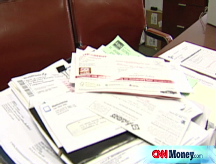The accounting rule you should care about
The battle over how banks and Wall Street value their assets is at the center of credit crisis and the debate over the $700 billion bailout plan.
NEW YORK (CNNMoney.com) -- It's easy to understand why the proposal to spend $700 billion in taxpayer money to rescue banks would inspire impassioned debate in Washington.
But in a sign of just how complex and controversial the current credit crisis has become, a move to potentially change accounting rules on how banks and Wall Street firms value the securities they own is almost as heated.
Some argue that tight accounting rules are a major reason for the credit crisis in the first place. Others contend that changing the rules will just bury problems lurking beneath the surface and could further shake investor confidence in the already battered financial sector.
First a bit of background. The one fact everyone agrees on is that the current financial crisis centers on trillions of dollars worth of mortgage loans that were packaged together into financial instruments known as mortgage-backed securities, or MBS. Those securities were purchased by banks and Wall Street firms.
But as home prices started to fall and foreclosures rose, the value of these securities plunged. Today, there is almost no market for the securities.
This is why Treasury Secretary Henry Paulson and Federal Reserve Chairman Ben Bernanke proposed that the government buy the securities. The hope is that doing so could restart the MBS market at something well above the current fire sale valuations and that the government could hold the securities until the market improves.
Some advocates of the plan argue that taxpayers will be able to eventually make money if the government sells the securities at a higher price down the road. But the more immediate hope is that banks and Wall Street firms, freed from the toxic loans on their balance sheet, will start lending again.
Still, others contend that it was not real financial losses from these securities that led to the credit crunch as much as it was an arcane accounting rule known as "mark-to-market."
Mark-to-market means that companies have to report what the fair value of their investments were if they sold them at the current time.
In recent years, firms were required by the Securities and Exchange Commission and the Federal Accounting Standards Board to use mark-to-market valuations for all the MBS on their books.
As more subprime borrowers started to default on their loans, that quickly eroded the value of many MBS pools. Major banks and financial firms around the globe have taken writedowns topping $500 billion in the last year, as a result.
For this reason, some have argued that fixing the rule would solve the credit crisis.
"The SEC has destroyed about $500 billion of capital by their continued insistence that mortgage-backed securities be valued at market value when there is no market," said William Isaac, a former chairman of the FDIC.
"And because banks essentially lend $10 for every dollar of capital they have, they've essentially destroyed $5 trillion in lending capacity," he added.
Isaac believes that since the overwhelming majority of loans packaged together in even the weakest MBS pools are not in foreclosure, it is proper to value these securities based on the flow of cash from all the loans instead of a non-existent market value.
Tuesday afternoon, the SEC and FASB seemed to change course on the rule, as they published new guidance to firms. The two organizations said when the market for a security disappears, it is now allowable to arrive at a value using "estimates that incorporate current market participant expectations of future cash flows, and include appropriate risk premiums, is acceptable."
In plain English, banks may not be forced to take huge writedowns on investments that lost all their value. But the guidance is just that: guidance. The SEC and FASB suggested that more concrete rule changes could come later.
While the possible end of mark-to-market might please critics of the rule, it doesn't satisfy everybody.
Some financial experts argue that even though banks and Wall Street firms may be able to make their balance sheets look better if the rule changes, these companies will be less attractive to investors because there isn't as much information about their true financial condition.
"The garbage is on the books and no one wants to admit the original error of purchasing this class of assets," said Barry Ritholtz, CEO of Fusion IQ, a research firm.
Ritholtz said mark-to-market accounting forces banks to honestly disclose what they own and how much those investments are worth. Changing the rule would make it tougher to come up with a bank's real value.
"I would advise our clients and the investing public that owning any financials that failed to disclose their holdings accurately is no longer an investment. It is pure speculation, with more in common to spinning a roulette wheel," he said.
Accounting experts also think that determining the value of pools of loans based on expected payments isn't any easier than figuring out their market value after demand has dried up. Rising default and foreclosure rates makes estimates about future value very suspect.
"People talk about 'hold to maturity', 'economic value.' I'm in the business and I don't know what that means," said David Larsen, managing director at financial advisory firm Duff & Phelps.
Larsen said that even with the new guidance from the SEC and FASB, it's not clear if accountants and chief financial officers are going to be able to ignore the sharp drop in market value for MBS pools in the current environment.
"To try to put a genie back in the bottle and go backwards from a transparency point of view makes little sense," said Larsen.
Others argue that the potential benefit to banks and Wall Street firms from a rule change is much less than is widely assumed since much of the writedowns have already occurred.
And it's too late to save the large financial institutions that have collapsed because of exposure to soured mortgages.
"I think mark to market is seen as a panacea, but I don't think it's that simple," said Brian Gardner, the Washington analyst for KBW, an investment firm that focuses on the financial services industry. "I don't think it's as big a deal for a lot of the banks." ![]()



